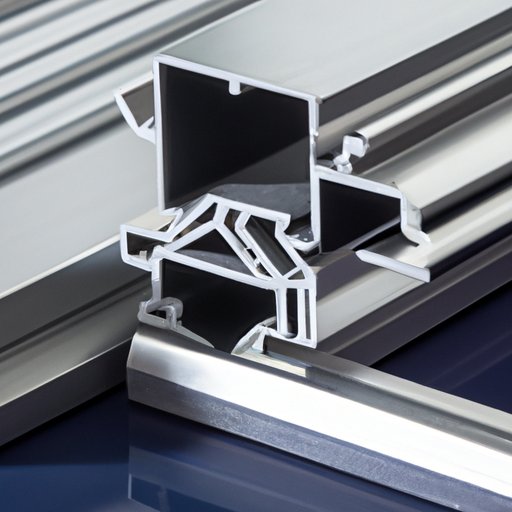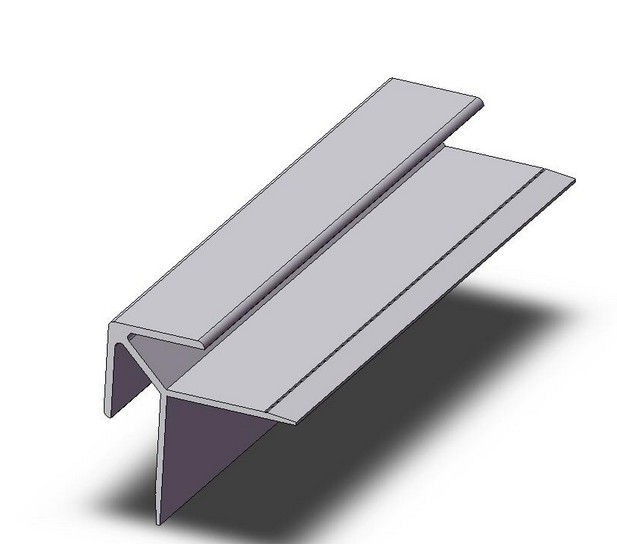Content Menu
● Introduction
● Benefits of Aluminum Corner Extrusions
>> Lightweight and Corrosion-Resistant Properties
>> Cost-Effectiveness and Durability
>> Aesthetic Appeal in Design
● Common Applications
>> Use in Construction and Architecture
>> Applications in Furniture and Cabinetry
>> Role in Automotive and Aerospace Industries
>> Use in Electronics and Appliances
>> Applications in Signage and Displays
● Choosing the Right Aluminum Corner Profiles
>> Factors to Consider: Geometry, Material, and Finish
>> Comparison of Standard vs. Custom Profiles
● Design Considerations for Aluminum Extrusions
>> Key Design Principles for Effective Use
>> Importance of Precision in Manufacturing
>> Tips for Optimizing Design for Strength and Functionality
● Conclusion
>> Related Questions
●
>> 1. What are the advantages of using aluminum extrusion corners over other materials?
>> 2. How can I choose the right aluminum corner profile for my project?
>> 3. What industries commonly use aluminum extrusion corners?
>> 4. How does the manufacturing process affect the quality of aluminum corners?
>> 5. Can aluminum extrusion corners be customized for specific applications?
Introduction
Aluminum extrusion corners are formed by shaping aluminum into specific profiles that are used to create strong, lightweight connections in various applications. The process of aluminum extrusion involves forcing heated aluminum through a die to create a desired shape. This method allows for the production of complex geometries that are not only functional but also visually appealing. The unique properties of aluminum, such as its resistance to corrosion, lightweight nature, and strength, make it an ideal material for corner extrusions.

Benefits of Aluminum Corner Extrusions
Aluminum corner extrusions offer numerous advantages that make them a preferred choice in many applications.
Lightweight and Corrosion-Resistant Properties
One of the most significant benefits of aluminum is its lightweight nature. This characteristic is particularly important in applications where weight reduction is crucial, such as in the automotive and aerospace industries. Additionally, aluminum is naturally resistant to corrosion, which means that aluminum extrusion corners can withstand harsh environmental conditions without deteriorating. This durability ensures a longer lifespan for products and structures that utilize aluminum corners.
Cost-Effectiveness and Durability
Aluminum extrusion corners are not only cost-effective but also durable. The manufacturing process allows for mass production, which reduces costs. Furthermore, aluminum's strength-to-weight ratio is superior to many other materials, making it an economical choice for structural applications. The longevity of aluminum components also contributes to lower maintenance costs over time.
Aesthetic Appeal in Design
Aluminum extrusion corners can be finished in various ways, including anodizing, powder coating, and painting. These finishes enhance the aesthetic appeal of the corners, allowing them to blend seamlessly into different design styles. Whether used in modern architecture or traditional furniture, aluminum corners can be customized to meet specific design requirements.
Common Applications
Aluminum extrusion corners are utilized in a wide range of applications across various industries. Here are some of the most common uses:

Use in Construction and Architecture
In the construction industry, aluminum extrusion corners are widely used in framing systems, window and door frames, and curtain walls. Their lightweight nature makes them easy to handle and install, while their strength provides structural support. Architects and builders often choose aluminum corners for their ability to create sleek, modern designs that are both functional and visually appealing.
Applications in Furniture and Cabinetry
Aluminum extrusion corners are also popular in furniture design and cabinetry. They are used to create strong joints in tables, chairs, and cabinets, providing stability and durability. The versatility of aluminum allows designers to create innovative furniture pieces that are both stylish and functional. Additionally, the ability to finish aluminum in various colors and textures enables designers to match the aesthetic of their furniture with the overall decor of a space.
Role in Automotive and Aerospace Industries
In the automotive and aerospace sectors, aluminum extrusion corners play a critical role in the construction of lightweight, fuel-efficient vehicles. The use of aluminum in these industries helps reduce overall weight, improving fuel efficiency and performance. Aluminum corners are used in various components, including chassis, body panels, and structural supports, ensuring that vehicles are both strong and lightweight.
Use in Electronics and Appliances
Aluminum extrusion corners are also found in the electronics and appliance industries. They are used in the frames of televisions, computer monitors, and kitchen appliances. The lightweight and durable nature of aluminum makes it an ideal choice for these applications, where both strength and aesthetics are important. Additionally, aluminum's ability to dissipate heat effectively makes it suitable for electronic enclosures.
Applications in Signage and Displays
Another common application for aluminum extrusion corners is in signage and display systems. Aluminum frames are used to create eye-catching signs that are both lightweight and durable. The ability to customize the shape and finish of aluminum corners allows businesses to create unique signage that stands out. Whether for indoor displays or outdoor advertising, aluminum corners provide the necessary support and aesthetic appeal.
Choosing the Right Aluminum Corner Profiles
When selecting aluminum corner profiles for a project, several factors should be considered to ensure optimal performance and aesthetics.
Factors to Consider: Geometry, Material, and Finish
The geometry of the aluminum corner profile is crucial for its intended application. Different shapes, such as L-shaped, T-shaped, or custom designs, can provide varying levels of strength and support. Additionally, the material used in the extrusion process can affect the overall performance of the corner. For example, using a higher-grade aluminum alloy may enhance strength and corrosion resistance.
The finish of the aluminum corner is also important for both functional and aesthetic reasons. Anodizing, powder coating, and painting can provide additional protection against corrosion and wear while allowing for customization in color and texture.
Comparison of Standard vs. Custom Profiles
While standard aluminum corner profiles are readily available, custom profiles can be designed to meet specific project requirements. Custom profiles allow for greater flexibility in design and can be tailored to fit unique applications. However, it is essential to consider the cost and lead time associated with custom extrusions, as they may require more time and resources to produce.
Design Considerations for Aluminum Extrusions
Designing with aluminum extrusion corners requires careful consideration of several key principles to ensure effectiveness and efficiency.
Key Design Principles for Effective Use
When designing with aluminum corners, it is essential to consider load-bearing requirements, joint configurations, and overall structural integrity. Properly designed corners can enhance the strength of a structure while minimizing material usage. Additionally, incorporating features such as drainage channels or thermal breaks can improve the performance of aluminum corners in specific applications.
Importance of Precision in Manufacturing
Precision in the manufacturing process is critical for ensuring that aluminum corner extrusions fit together correctly. Accurate measurements and tolerances are necessary to achieve strong joints and connections. Investing in high-quality manufacturing processes can lead to better overall performance and longevity of the final product.
Tips for Optimizing Design for Strength and Functionality
To optimize the design of aluminum corner extrusions, consider the following tips:
- Use appropriate wall thickness to balance strength and weight.
- Incorporate reinforcement features, such as ribs or gussets, to enhance strength.
- Ensure proper alignment and fit during assembly to prevent stress concentrations.
- Consider the environmental conditions the aluminum corners will be exposed to and select finishes accordingly.
Conclusion
Aluminum extrusion corners are versatile components that play a vital role in various industries, from construction and furniture design to automotive and electronics. Their lightweight, durable, and corrosion-resistant properties make them an ideal choice for a wide range of applications. By understanding the benefits and common uses of aluminum corner extrusions, designers and engineers can make informed decisions that enhance the performance and aesthetics of their projects.

Related Questions
1. What are the advantages of using aluminum extrusion corners over other materials?
Aluminum extrusion corners offer lightweight, corrosion resistance, and durability, making them ideal for various applications. Their aesthetic appeal and cost-effectiveness further enhance their advantages.
2. How can I choose the right aluminum corner profile for my project?
Consider factors such as geometry, material, finish, and load-bearing requirements when selecting an aluminum corner profile. Custom profiles may be necessary for unique applications.
3. What industries commonly use aluminum extrusion corners?
Aluminum extrusion corners are widely used in construction, furniture design, automotive, aerospace, electronics, and signage industries.
4. How does the manufacturing process affect the quality of aluminum corners?
Precision in the manufacturing process is crucial for ensuring accurate dimensions and tolerances, which directly impacts the strength and performance of aluminum corners.
5. Can aluminum extrusion corners be customized for specific applications?
Yes, aluminum extrusion corners can be customized to meet specific design and performance requirements, allowing for greater flexibility in various applications.






















